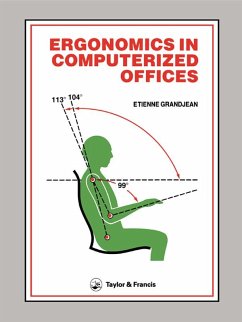E. Grandjean
Ergonomics In Computerized Offices (eBook, PDF)
73,95 €
73,95 €
inkl. MwSt.
Sofort per Download lieferbar

37 °P sammeln
73,95 €
Als Download kaufen

73,95 €
inkl. MwSt.
Sofort per Download lieferbar

37 °P sammeln
Jetzt verschenken
Alle Infos zum eBook verschenken
73,95 €
inkl. MwSt.
Sofort per Download lieferbar
Alle Infos zum eBook verschenken

37 °P sammeln
E. Grandjean
Ergonomics In Computerized Offices (eBook, PDF)
- Format: PDF
- Merkliste
- Auf die Merkliste
- Bewerten Bewerten
- Teilen
- Produkt teilen
- Produkterinnerung
- Produkterinnerung

Bitte loggen Sie sich zunächst in Ihr Kundenkonto ein oder registrieren Sie sich bei
bücher.de, um das eBook-Abo tolino select nutzen zu können.
Hier können Sie sich einloggen
Hier können Sie sich einloggen
Sie sind bereits eingeloggt. Klicken Sie auf 2. tolino select Abo, um fortzufahren.

Bitte loggen Sie sich zunächst in Ihr Kundenkonto ein oder registrieren Sie sich bei bücher.de, um das eBook-Abo tolino select nutzen zu können.
"Ergonomics in Computerized Offices should be required reading for office managers, union representatives, engineers, designers, or anyone employed in implementing a computerized office or improving conditions in an already computerized office...an excellent addition to any personal library."--Human Factors Bulletin
- Geräte: PC
- mit Kopierschutz
- eBook Hilfe
Andere Kunden interessierten sich auch für
![Ergonomics In Computerized Offices (eBook, ePUB) Ergonomics In Computerized Offices (eBook, ePUB)]() E. GrandjeanErgonomics In Computerized Offices (eBook, ePUB)73,95 €
E. GrandjeanErgonomics In Computerized Offices (eBook, ePUB)73,95 €![The Dictionary for Human Factors/Ergonomics (eBook, PDF) The Dictionary for Human Factors/Ergonomics (eBook, PDF)]() Jr. StramlerThe Dictionary for Human Factors/Ergonomics (eBook, PDF)61,95 €
Jr. StramlerThe Dictionary for Human Factors/Ergonomics (eBook, PDF)61,95 €![Office Ergonomics (eBook, PDF) Office Ergonomics (eBook, PDF)]() Karl H. E. KroemerOffice Ergonomics (eBook, PDF)61,95 €
Karl H. E. KroemerOffice Ergonomics (eBook, PDF)61,95 €![Handbook of Environmental Health, Volume II (eBook, PDF) Handbook of Environmental Health, Volume II (eBook, PDF)]() Herman KorenHandbook of Environmental Health, Volume II (eBook, PDF)96,95 €
Herman KorenHandbook of Environmental Health, Volume II (eBook, PDF)96,95 €![Handbook of Environmental Health, Volume I (eBook, PDF) Handbook of Environmental Health, Volume I (eBook, PDF)]() Herman KorenHandbook of Environmental Health, Volume I (eBook, PDF)96,95 €
Herman KorenHandbook of Environmental Health, Volume I (eBook, PDF)96,95 €![Handbook of Human Factors and Ergonomics Methods (eBook, PDF) Handbook of Human Factors and Ergonomics Methods (eBook, PDF)]() Handbook of Human Factors and Ergonomics Methods (eBook, PDF)61,95 €
Handbook of Human Factors and Ergonomics Methods (eBook, PDF)61,95 €![Illustrated Dictionary and Resource Directory of Environmental and Occupational Health (eBook, PDF) Illustrated Dictionary and Resource Directory of Environmental and Occupational Health (eBook, PDF)]() Herman KorenIllustrated Dictionary and Resource Directory of Environmental and Occupational Health (eBook, PDF)96,95 €
Herman KorenIllustrated Dictionary and Resource Directory of Environmental and Occupational Health (eBook, PDF)96,95 €-
-
-
"Ergonomics in Computerized Offices should be required reading for office managers, union representatives, engineers, designers, or anyone employed in implementing a computerized office or improving conditions in an already computerized office...an excellent addition to any personal library."--Human Factors Bulletin
Dieser Download kann aus rechtlichen Gründen nur mit Rechnungsadresse in A, B, BG, CY, CZ, D, DK, EW, E, FIN, F, GR, HR, H, IRL, I, LT, L, LR, M, NL, PL, P, R, S, SLO, SK ausgeliefert werden.
Produktdetails
- Produktdetails
- Verlag: Taylor & Francis eBooks
- Seitenzahl: 248
- Erscheinungstermin: 18. Dezember 1986
- Englisch
- ISBN-13: 9781135482046
- Artikelnr.: 57589504
- Verlag: Taylor & Francis eBooks
- Seitenzahl: 248
- Erscheinungstermin: 18. Dezember 1986
- Englisch
- ISBN-13: 9781135482046
- Artikelnr.: 57589504
- Herstellerkennzeichnung Die Herstellerinformationen sind derzeit nicht verfügbar.
Etienne Grandjean, Former Director of the Department of Ergonomics and Hygiene, Swiss Federal Institute of Technology, Zürich.
Foreword 1 The present metamorphosis of offices 2 VDT jobs seen through
ergonomic-tinted spectacles 3 Physical characteristics of VDTs 4 Vision
4.1. The visual system 4.2. Accommodation 4.3. The aperture of the pupil
4.4. The adaptation of the retina 4.5. Eye movements 4.6. Visual capacities
4.7. Physiology of reading 5 Ergonomic principles of lighting in offices
5.1. Light measurement and light sources 5.2. Illumination level 5.3.
Spatial balance of surface luminances 5.4. Temporal uniformity of lighting
5.5. Appropriate lights 6 Visual strain and photometric characteristics of
VDTs 6.1. Eye complaints of VDT operators 6.2. Photometric characteristics
of displays 6.3. Equipment and methods to measure photometric qualities of
VDTs 6.4. Oscillating luminances of characters 6.5. Sharpness of characters
6.6. Character contrasts 6.7. Stability of characters 6.8. Reflections on
screen surfaces 6.9. Size of characters and typeface 6.10. Dark versus
bright characters 7 Ergonomic design of VDT workstations 7.1. Constrained
postures are long-lasting static efforts for the muscles involved 7.2. Body
size and the design of workstations for traditional office jobs 7.3. Field
studies on musculoskeletal troubles of office employees 7.4. Postures,
workstation characteristics and physical discomfort 7.5. Orthopaedic
aspects of the sitting posture 7.6. Ergonomic design of office chairs 7.7.
VDT workstation design: preferred settings and their effects 7.8. The VDT
keyboard 7.9. Arrangement of work surfaces in computerized offices 8 Noise
9 Occupational stress, work satisfaction and job design 9.1. Occupational
stress 9.2. Job satisfaction versus boredom 9.3. Alleged stress among VDT
operators 9.4. Job design 10 Radiation, electrostatic fields and alleged
health hazards 10.1. Electromagnetic radiation emission from VDTs 10.2.
Electrostatic fields 10.3. Skin rashes 10.4. Alleged cataracts 10.5.
Alleged reproductive hazards due to VDT work 11 Recommendations for VDT
workstations 11.1. Lighting 11.2. Photometric qualities of VDTs 11.3.
Ergonomic design of office furniture and keyboards 11.4. Job design for VDT
operators
ergonomic-tinted spectacles 3 Physical characteristics of VDTs 4 Vision
4.1. The visual system 4.2. Accommodation 4.3. The aperture of the pupil
4.4. The adaptation of the retina 4.5. Eye movements 4.6. Visual capacities
4.7. Physiology of reading 5 Ergonomic principles of lighting in offices
5.1. Light measurement and light sources 5.2. Illumination level 5.3.
Spatial balance of surface luminances 5.4. Temporal uniformity of lighting
5.5. Appropriate lights 6 Visual strain and photometric characteristics of
VDTs 6.1. Eye complaints of VDT operators 6.2. Photometric characteristics
of displays 6.3. Equipment and methods to measure photometric qualities of
VDTs 6.4. Oscillating luminances of characters 6.5. Sharpness of characters
6.6. Character contrasts 6.7. Stability of characters 6.8. Reflections on
screen surfaces 6.9. Size of characters and typeface 6.10. Dark versus
bright characters 7 Ergonomic design of VDT workstations 7.1. Constrained
postures are long-lasting static efforts for the muscles involved 7.2. Body
size and the design of workstations for traditional office jobs 7.3. Field
studies on musculoskeletal troubles of office employees 7.4. Postures,
workstation characteristics and physical discomfort 7.5. Orthopaedic
aspects of the sitting posture 7.6. Ergonomic design of office chairs 7.7.
VDT workstation design: preferred settings and their effects 7.8. The VDT
keyboard 7.9. Arrangement of work surfaces in computerized offices 8 Noise
9 Occupational stress, work satisfaction and job design 9.1. Occupational
stress 9.2. Job satisfaction versus boredom 9.3. Alleged stress among VDT
operators 9.4. Job design 10 Radiation, electrostatic fields and alleged
health hazards 10.1. Electromagnetic radiation emission from VDTs 10.2.
Electrostatic fields 10.3. Skin rashes 10.4. Alleged cataracts 10.5.
Alleged reproductive hazards due to VDT work 11 Recommendations for VDT
workstations 11.1. Lighting 11.2. Photometric qualities of VDTs 11.3.
Ergonomic design of office furniture and keyboards 11.4. Job design for VDT
operators
Foreword 1 The present metamorphosis of offices 2 VDT jobs seen through
ergonomic-tinted spectacles 3 Physical characteristics of VDTs 4 Vision
4.1. The visual system 4.2. Accommodation 4.3. The aperture of the pupil
4.4. The adaptation of the retina 4.5. Eye movements 4.6. Visual capacities
4.7. Physiology of reading 5 Ergonomic principles of lighting in offices
5.1. Light measurement and light sources 5.2. Illumination level 5.3.
Spatial balance of surface luminances 5.4. Temporal uniformity of lighting
5.5. Appropriate lights 6 Visual strain and photometric characteristics of
VDTs 6.1. Eye complaints of VDT operators 6.2. Photometric characteristics
of displays 6.3. Equipment and methods to measure photometric qualities of
VDTs 6.4. Oscillating luminances of characters 6.5. Sharpness of characters
6.6. Character contrasts 6.7. Stability of characters 6.8. Reflections on
screen surfaces 6.9. Size of characters and typeface 6.10. Dark versus
bright characters 7 Ergonomic design of VDT workstations 7.1. Constrained
postures are long-lasting static efforts for the muscles involved 7.2. Body
size and the design of workstations for traditional office jobs 7.3. Field
studies on musculoskeletal troubles of office employees 7.4. Postures,
workstation characteristics and physical discomfort 7.5. Orthopaedic
aspects of the sitting posture 7.6. Ergonomic design of office chairs 7.7.
VDT workstation design: preferred settings and their effects 7.8. The VDT
keyboard 7.9. Arrangement of work surfaces in computerized offices 8 Noise
9 Occupational stress, work satisfaction and job design 9.1. Occupational
stress 9.2. Job satisfaction versus boredom 9.3. Alleged stress among VDT
operators 9.4. Job design 10 Radiation, electrostatic fields and alleged
health hazards 10.1. Electromagnetic radiation emission from VDTs 10.2.
Electrostatic fields 10.3. Skin rashes 10.4. Alleged cataracts 10.5.
Alleged reproductive hazards due to VDT work 11 Recommendations for VDT
workstations 11.1. Lighting 11.2. Photometric qualities of VDTs 11.3.
Ergonomic design of office furniture and keyboards 11.4. Job design for VDT
operators
ergonomic-tinted spectacles 3 Physical characteristics of VDTs 4 Vision
4.1. The visual system 4.2. Accommodation 4.3. The aperture of the pupil
4.4. The adaptation of the retina 4.5. Eye movements 4.6. Visual capacities
4.7. Physiology of reading 5 Ergonomic principles of lighting in offices
5.1. Light measurement and light sources 5.2. Illumination level 5.3.
Spatial balance of surface luminances 5.4. Temporal uniformity of lighting
5.5. Appropriate lights 6 Visual strain and photometric characteristics of
VDTs 6.1. Eye complaints of VDT operators 6.2. Photometric characteristics
of displays 6.3. Equipment and methods to measure photometric qualities of
VDTs 6.4. Oscillating luminances of characters 6.5. Sharpness of characters
6.6. Character contrasts 6.7. Stability of characters 6.8. Reflections on
screen surfaces 6.9. Size of characters and typeface 6.10. Dark versus
bright characters 7 Ergonomic design of VDT workstations 7.1. Constrained
postures are long-lasting static efforts for the muscles involved 7.2. Body
size and the design of workstations for traditional office jobs 7.3. Field
studies on musculoskeletal troubles of office employees 7.4. Postures,
workstation characteristics and physical discomfort 7.5. Orthopaedic
aspects of the sitting posture 7.6. Ergonomic design of office chairs 7.7.
VDT workstation design: preferred settings and their effects 7.8. The VDT
keyboard 7.9. Arrangement of work surfaces in computerized offices 8 Noise
9 Occupational stress, work satisfaction and job design 9.1. Occupational
stress 9.2. Job satisfaction versus boredom 9.3. Alleged stress among VDT
operators 9.4. Job design 10 Radiation, electrostatic fields and alleged
health hazards 10.1. Electromagnetic radiation emission from VDTs 10.2.
Electrostatic fields 10.3. Skin rashes 10.4. Alleged cataracts 10.5.
Alleged reproductive hazards due to VDT work 11 Recommendations for VDT
workstations 11.1. Lighting 11.2. Photometric qualities of VDTs 11.3.
Ergonomic design of office furniture and keyboards 11.4. Job design for VDT
operators







